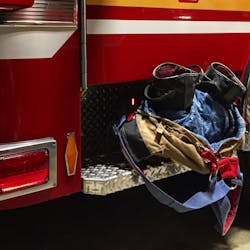Some of the best lessons I’ve learned in the fire service have been learned casually, informally, from people who didn’t even realize they were teaching me anything, much less that they were helping to mold the type of firefighter I am trying to be on a daily basis. Many of these lessons were learned outside of my station, outside of the shift, and often even outside of my fire department. There’s so much value in taking classes, attending seminars, conferences and the like. But again, the lessons I’m sharing here weren’t learned in a classroom. They were picked up from just simple observations or even conversations around the breakfast table. I’d like to share four of the key lessons—lessons that lead to big payoffs in the long run.
1. Control what you can control, because this job doesn’t offer a lot of room for much else.
I was visiting Station 1 in Cary, NC. I was enamored with the beautiful stations in the town, as well as the genuine passion for the job that was embodied by so many firefighters down there. I was speaking with one of the captains when the tones dropped, and everyone in the station literally sprinted toward their gear before the dispatcher even started listing apparatus that were being called. As it turned out, only the truck company was being dispatched, and the engine company began undressing and returning to what they had been doing.
I commented to the captain that I thought the crews’ response was awesome. I had never seen such urgency. The captain then made a great point: He requires his crew to run to the trucks when the tones drop, because that’s the only time they can control how quickly they get to the scene. He went on to say that you could never know exactly how the response will go. You may encounter a lot of traffic, the traffic signals may with your team when you’re pulling up to an intersection, or you may even have to take a route different than you were expecting for whatever reason. The captain told me his men and women respond before even being told to respond. He expects his people to anticipate running a call every time the station tones drop, and to be as close to being ready to go as possible by the time the dispatcher actually calls their truck.
To some, this may seem excessive, but to me, that’s a mark of someone who takes this job as seriously as everyone should. We cannot control every aspect of any response, but we can make sure we are making the best out of every opportunity we do have to respond as smoothly and quickly as possible.
2. Be prepared to work, no matter which seat you’re riding.
I recently worked overtime and rode the backseat of our city’s only rescue company. As we responded to a reported structure fire, I noticed the driver getting dressed before jumping in the driver’s seat. Now this was my first time riding the rescue, but I have seen the driver on my shift jump off the truck just in his station uniform, which is essentially the norm for drivers on any truck. Of course, if the rescue is going to work, he’ll get dressed—and he can do it quicker than most—while the rest of the crew gets their tools or whatever is needed. And for them, this works pretty well.
But I was inspired by that driver on the other shift. If you think about it, the rest of the crew is already taking the time to get dressed before the truck leaves the station. If the driver utilizes that time to also at least don their bunker pants, you’re saving precious time on the fireground if the stuff hits the fan. And this applies to every piece of fire apparatus.
As the driver on the engine, I will probably be pumping if we catch a fire in our first due. But what happens if it turns into a rescue when we arrive? I now need to take the time to get dressed on scene to join my crew inside. Not to mention, whether you admit it or not, being present at that sort of situation gets your nerves up a bit, and now you may not be moving as smoothly as you would be if you were getting dressed in the station beforehand, which in turn also slows down how quickly you can be ready to go.
So, I have a new system for myself. My engine has a compartment next to the pump panel for the driver’s gear, so I leave that compartment door open with my bunker pants easily accessible. If we get toned for a fire, I can get my pants on before jumping on the truck, and if we are responding to a medical call, all I have to do is shut the compartment door on the way to my seat. Again, this is something little, something seemingly insignificant, that could have a significant impact on the time spent preparing to do the work required of me when I arrive on scene.
3. Use hydrants as landmarks when responding no matter the call.
I was driving the medic unit on the way to a call when the visiting ALS provider looked up from the mobile data terminal (MDT) to tell me that the house we were going to was right past the second hydrant on the right in the 1500 block. We were still about a mile away from the scene, but this little tidbit of information made me more aware of the hydrants on the way to the call.
As an engine driver especially, knowing the hydrant locations in your territory is a very significant aspect of your duties. But to be honest, I typically never think to pay attention to where the hydrants are when we are just driving around, and I especially do not pay attention when we are responding to an incident, much less during an EMS response. However, when my partner called my attention to the hydrants, and even used them as landmarks, I was able to sort of zoom out from the tunnel vision, from trying to see those tiny numbers on mailboxes, and in a sense, I was preplanning for any future fire calls we may run in that part of the territory. Even if I don’t remember specifically where that hydrant is located if you were to ask me at any given moment, if we respond to that area again, I will be better equipped to find the plug during an emergency, because not only will I remember the nearest street/intersection, but now I have the house, cars, trees, etc., etched in my memory.
4. Use every call as a chance to preplan.
The hydrant story lends itself to a similar and equally important concept. Every call you run is an opportunity to preplan. Some people balk at the word “preplan,” arguing that, “no matter what, we still know we have to do the job, so it doesn’t matter if we’ve been there before” or “it’s not like we’re going to remember everything when we actually show up for a fire.” Sure, but I would much rather be the slightest bit more prepared for any incident than not at all. When you run an EMS call at that big warehouse down the street, are you paying attention to the exits, FDC locations, nearest hydrants, sprinkler systems, breaker boxes, power lines, extenuating hazards or any other myriad hazards we need to be aware of as firefighters?
My shift recently had a structure fire at a house that happened to be well off the beaten path. The house carried an address that seemed pretty easy to find. The road was pretty busy, it was right in the middle of the city, and that part of the city has a fairly high number of medical calls, so to everyone responding, it was a pretty cut-and-dry kind of run. However, the radio quickly became filled with engine companies asking dispatch to verify the address or to advise on any information regarding a hidden driveway because that house was nowhere to be found. Luckily, a paramedic overhearing the incident while at the ER keyed up and instructed the trucks responding on how to get to the house—with much specificity—because he had been there for several EMS calls and knew that the house had a hard-to-reach, hard-to-see driveway. To even better serve his fellow firefighters, he also pointed out that the driveway had a low-hanging power cable that would not allow anything taller than an ambulance to get through. Because of his awareness during other calls, he was able to prevent a pretty nasty incident had the truck and engine companies not known about that wire.
That call is only one example of the value that comes from paying attention and taking advantage of every opportunity to learn and prepare for the next incident.
Final thoughts
To some, the learning aspect of this profession ends at the fire academy graduation. But if you want to excel, if you want to stand out, if you want to make a difference, you need to stay ahead of the game. And that only comes from paying attention, soaking in every lesson you can get your hands on, and just genuinely taking this job seriously. We can learn so much from the people around us, and in a profession that never stops evolving, it is imperative that we take some responsibility and make our own education and professional development a priority. Watch the senior guys. Sign up for classes. Don’t discredit the newer folks just because they haven’t been around for very long. And never stop learning.






